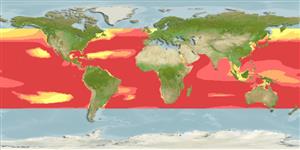>
Myctophiformes (Lanternfishes) >
Myctophidae (Lanternfishes) > Notolychninae
Etymology: Notolychnus: Greek, noton = back + Greek, lychnos, -ou = torch (Ref. 45335).
Eponymy: Both these species are named after the research vessel ‘Valdivia’ and the Valdivia expedition (1898–1899), Germany’s first expedition to explore deep seas. The holotypes were collected during the expedition. (Ref. 128868), visit book page.
Environment: milieu / climate zone / depth range / distribution range
Écologie
marin bathypélagique; océanodrome (Ref. 51243); profondeur 25 - 700 m (Ref. 4066). Deep-water; 56°N - 40°S, 180°W - 180°E
Worldwide distribution in tropical, subtropical and temperate waters. Eastern Atlantic: west of British Isles and Bay of Biscay to South Africa. Western Atlantic: Canada to Argentina. Western Pacific: between 0° and 32°S. Eastern Pacific: between 32°N and 30°S, but with 20°S southern limit in Peruvian Transitional Zone. Eastern Indian Ocean: between 9°-32°S.
Length at first maturity / Taille / Poids / Âge
Maturity: Lm 1.7 range ? - ? cm
Max length : 6.3 cm TL mâle / non sexé; (Ref. 26340)
Épines dorsales (Total) : 0; Rayons mous dorsaux (Total) : 10 - 12; Épines anales: 0; Rayons mous anaux: 12 - 15; Vertèbres: 27 - 31. Branchiostegal rays: 9 (Ref. 31422). Anal organs 8; a single deeply set translucent supracaudal gland present in both sexes, but no infracaudal gland; males have much larger eyes and a longer supracaudal gland than those of females (Ref. 39633).
High-oceanic, epipelagic and mesopelagic (Ref. 4479). Found between 375-700 m during the day and between 25-350 m at night (Ref. 4066). Size stratification with depth during the day only (Ref. 4775). Juveniles migratory; adults migratory, partially migratory or non-migratory (Ref. 4775). Feed on copepods, conchoecid ostracods and euphausiids (Ref. 4775). Oviparous, with planktonic eggs and larvae (Ref. 31442). Also Ref. 58302.
Hulley, P.A., 1990. Myctophidae. p. 398-467. In J.C. Quero, J.C. Hureau, C. Karrer, A. Post and L. Saldanha (eds.) Check-list of the fishes of the eastern tropical Atlantic (CLOFETA). JNICT, Lisbon; SEI; Paris; and UNESCO, Paris. Vol. 1. (Ref. 4479)
Statut dans la liste rouge de l'IUCN (Ref. 130435: Version 2024-1)
Menace pour l'homme
Harmless
Utilisations par l'homme
Outils
Articles particuliers
Télécharger en XML
Sources Internet
Estimates based on models
Preferred temperature (Ref.
123201): 10 - 22.8, mean 15.2 °C (based on 1055 cells).
Phylogenetic diversity index (Ref.
82804): PD
50 = 1.0000 [Uniqueness, from 0.5 = low to 2.0 = high].
Bayesian length-weight: a=0.00389 (0.00180 - 0.00842), b=3.12 (2.94 - 3.30), in cm total length, based on all LWR estimates for this body shape (Ref.
93245).
Niveau trophique (Ref.
69278): 3.1 ±0.20 se; based on food items.
Résilience (Ref.
120179): Milieu, temps minimum de doublement de population : 1,4 à 4,4 années (tmax=1; k >0.30).
Fishing Vulnerability (Ref.
59153): Low vulnerability (10 of 100).
